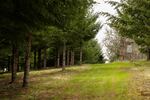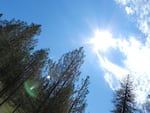The Ochoco National Forest has released a plan for a 137-mile trail system specifically for off-highway vehicles.
Forest officials expressed the hope that more designated areas for OHV riders will reduce the illegal cross-country riding that happens now.
"We can start leaning in on law enforcement and public education, and start sorting out legitimate use from unauthorized access," said Stacey Forson, a forest supervisor. "It’s been challenging to do that without having a suitable system of routes for recreation users."
But environmental groups aren't convinced.
"By designating the OHV trail system, I actually think the Forest Service will increase illegal use across the forest," said Sarah Cuddy with Oregon Wild.

A person rides a dirt bike at a terminus of the Weldon Wagon Trail in southern Washington. The Forest Service wants to create 137 miles of new off-highway vehicle trails in the Ochoco National Forest in Oregon.
Bradley W. Parks / OPB
OHV users have few designated trails in the Ochocos, although riders can currently use 659 miles of dirt roads in the forest, according to the Forest Service. The decision will more than quadruple the number of OHV-designed trails in the Ochoco National Forest.
The plan is, in part, a response to a 2011 travel management plan developed by the Forest Service, which closed some roads to OHV use to protect archaeological and natural resources. Those closures frustrated some OHV-users.
Environmental groups swiftly sued against the plan Thursday, citing potential harm to wildlife and fish habitat such as Rocky Mountain elk, mule deer, redband trout and gray wolves.
Related: Plan Would Limit Entry To Key Oregon Wilderness Areas
"This allows for motorized recreation in old growth management areas and scablands, which are really some of the most pristine wildlife habitat that we have in the forest," Cuddy said.
Forson said she can’t comment on pending litigation, but added the Forest Service developed the plan so the OHV trails will have minimal impact on natural resources. She pointed out that the planned trails avoid the highest concentration of elk habitat, prohibits winter trail use when wildlife are especially sensitive, and minimizes the number of times vehicles will cross over or through streams.
Joanne Richter of the Great Old Broads for Wilderness Bitterbrush Group, a watershed scientist, disputed that.
“The Forest Service has significantly downplayed the potential impacts of proposed stream crossings, particularly new crossings of Deep Creek that could cause irreparable harm to riparian vegetation, aquatic invertebrates and redband trout habitat.”

Ochoco National Forest in 2011.
Nick Perla/Flickr
The Forest Service does not have an estimated cost for the trail system, but officials expect the funding to come from a mixture of federal dollars, grants and partners. There's no new funding specifically allocated for the trail system or law enforcement.
Forson emphasized that these 137 miles will be spread over the entire Ochoco National Forest.
"People may view it as a big project," she said, "but when you think about all the other opportunity out there, it’s a fairly limited system."